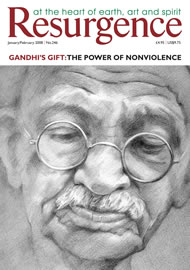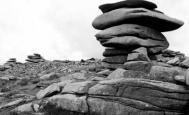IN CONTRAST TO today’s secularised art world the context for art in prehistory was essentially religious ceremony. Art before ‘art’ was a song of the soul. Indeed, many traditional cultures to this day have no word for ‘art’, it being considered an activity seamlessly integrated into spiritual praxis. The formal sensibilities that go into today’s version of art forms like minimalism, installation art, conceptual art and the rest belong to the dawn of human consciousness. They are not ‘modern’ as such, but originate in a context that was sacred.
A couple of years ago, I was leafing through a huge tome on minimalist art which referred to the 1960s as the “prehistory” of the art form! This is akin to an aesthetic Alzheimer’s syndrome where memory of our roots and motivations has been completely lost. To not know the origin and the background of what we do is a huge problem in our culture. These artistic movements float on a much deeper and more spiritual water than is commonly understood. This becomes apparent even if we trace just a few examples of the formal precursors of a selection of artistic movements we would normally think of as being quintessentially contemporary.
Conceptual art
The somewhat cerebral concept-art we find in modern galleries has a deep prehistory. In early times we might refer to conceptualism as ‘dreamtime perception’: there was no essential difference to the formal processes involved today, yet there is a fundamental difference in meaning.
The first conceptual art saw tribal deities, heroes and narratives in the lie of the land. The anthropologist Lucien Lévy-Bruhl noted that to traditional peoples the natural environment was a living book “in which the myths are inscribed . . . A legend is captured in the very outlines of the landscape.”
The spirit of the land stared back at early humanity from topographical images – mountain contours and rock outcrops evoking human, animal, or symbolic shapes. Classic instances of this in the Celtic world were rounded mountains, often referred to by the Celtic term ‘paps’ (breasts). But the conceptualisation is even older than Celtic. For example the Paps of Jura, on the island of Jura, twenty miles off the Kintyre peninsula in Scotland. When viewed from the Neolithic standing stones of Ballochroy on Kintyre, the midsummer sun appears to set into the Paps, as if settling into the breast of the Earth Mother. Viewed from Loch Finlaggen on the isle of Islay, immediately adjacent to the southern tip of Jura, the two Paps rear up dramatically over the skyline. That this skyline eruption made the loch sacred is indicated by the fact that a Neolithic stone row pointed from the loch towards the Paps.
In Australia, the Aboriginal conception of the topography as being formed by Dreamtime heroes, of ancestral beings transformed into place, is now well known, but similar conceptualisations also occurred in Greenland, Britain and Egypt and all around the ancient world.
The conceptualised territories of ancient peoples encoded their tribal memory, reinforcing their sense of belonging – the reverse of the alienating private myths of today’s individualistic conceptual art. If the tribal people are removed from their native landscape it can occasion a form of collective amnesia leading to social decline.
Minimalism
It is hard to believe that minimalist art had prehistoric precursors, yet that particular creative process was known as far back as the Stone Age, though again within a different context.
In various ancient cultures at various times people started to lightly embellish the natural places they had previously only perceived through mythic filters and venerated. There was a range of ways in which such minimalist expression took place in addition to the application of rock art imagery to special locations. A few examples can testify to this. The Stone Age people of Bodmin Moor rearranged the erosion litter of small rocks around natural tors – this was so subtle that archaeologists have only recently realised that it took place. A case in point is the Cheesewring, a massive rock outcrop eroded into weird shapes by rain and wind over millennia.
From the Andes to Ireland, rocks, gravels and clays from natural venerated places were transported considerable distances to be used in the construction of temples and monuments when people began to build artificial sacred places. Even the placing of some stone circles in Britain had minimalist overtones, their locations being precisely selected to allow tight sightlines to venerated topographical features. The Hurlers, for example, a triple stone circle complex on Bodmin Moor, is placed so that the Cheesewring appears to sit exactly on the horizon.
Land art
We might think that land artists like Richard Long, Andy Goldsworthy or James Turrell represent a contemporary artistic phenomenon. But land art existed in ancient times. Among the least noted works of prehistoric art are geoglyphs: large-scale ground markings. They were made in a variety of ways. Some were incised into desert surfaces and are known as intaglios, for they are indeed a form of etching. Others were made by the placing of small rocks and boulders on desert and table-rock surfaces and are called boulder mosaics or petroforms. Others, referred to as effigy mounds, were modelled out of clay.
The prehistoric chalk-hill figures in southern England are examples of geoglyphs. But the greatest variety of land art has survived in the Americas. The mysterious Nazca lines of Peru are probably the best known of these, but there are other similar features throughout the Americas. In Death Valley, California, there are curious lines of stones thought to relate to ancient vision quests or shamanic sorcery. At Tie Creek in Manitoba, areas of bare table-rock are emblazoned with huge petroform patterns dating back about 1,500 years. Ojibway Indians claim that they are landscape-scale versions of their ancient bark scrolls recording the cultural myths.
Installation art
In the contemporary gallery environment we are used to seeing and hearing video installations, the glow of neon tubing, or the ambient babble of looped audio recordings within installation structures. Such installation art would seem to be necessarily a modern art form, yet audio-visual sensibility was present in the pre-electric ancient world too.
Installation artists of the past produced spiritual son et lumière displays at sacred sites all over the world.
A classic case is that of El Castillo in the ancient Mayan ceremonial city of Chichén Itzá, Mexico. This stepped pyramid supports a temple dedicated to Kukulcan, the Feathered Serpent (the Quetzalcoatl of the later Aztecs). At the equinoxes the rising sun causes a corner of the pyramid to cast a serrated shadow reminiscent of the local diamond-back rattlesnake onto the balustrade of a ceremonial stairway on the northern face of the structure. This light-and-shade ‘serpent’ appears to slither down from the temple to connect with a carved stone serpent’s head at the bottom of the balustrade.
Fairly recently, it has been found that percussive sounds made in front of the stairway produce echoes that have a similar acoustic signature to the primary call of the quetzal bird, whose colourful plumage was worn by the priests of Kukulcan. Such acoustic symbolism is now beginning to be noted at other sites worldwide.
Naturally musical (‘ringing’) rocks are being recognised in association with some rock-art sites around the world, the type of locations where distinctive echo phenomena are also being noted. For instance, ancestral Algonquin rock paintings on Mazinaw Rock in Bon Echo Provincial Park, Ontario, cluster in the areas of strongest echoes. This may relate to the former belief of American Indians that spirits lived inside rocks and behind cliff-faces.
Sunshine and moonlight were bent to the purpose of sacred showmanship in numerous Stone Age monuments, the most famous probably being the midwinter sunrise light-beam entering Newgrange in Ireland. Even more spectacular effects occur at Neolithic cairns at Loughcrew, also in Ireland, where sunlight is formed into laser-like beams by the monuments’ construction so as to illuminate monoliths and rock-art panels inside the cairns’ chambers – cosmic software running within the old monumental hardware.
THE OLD ADAGE tells us that we cannot know where we are going unless we know where we have come from. In The Old Road, Hilaire Belloc puts it more eloquently: “By the recovery of the Past, stuff and being are added to us; our lives which, lived in the present only, are a film or surface, take on body . . . The soul is fed.” Art is too important a process for it to become the superficial “film or surface” that the gallery-focused cultural activity called ‘art’ today has tended to become. The current mainstream view requires a ‘back to the future’ conversion so that it can recognise art as being the song of the soul that it is and always was. Art has its roots in the land itself, in the soil of sanctity.







